Avete mai provato ad aprire uno dei vostri post su WordPress per poi essere accolti da un errore 404? A volte ci capita quando lavoriamo sui nostri siti WordPress o aiutiamo i nostri utenti a risolvere il problema.
Questo errore si verifica quando si riesce ad accedere all’area di amministrazione di WordPress e al blog, ma quando si cerca di aprire un post specifico, viene visualizzato il messaggio “404 Not Found”.
Può essere frustrante vedere i propri contenuti apparentemente scomparire, ma abbiamo trovato alcune soluzioni per risolvere questo problema. In questa guida completa, vi mostreremo come risolvere i post di WordPress che restituiscono errori 404.
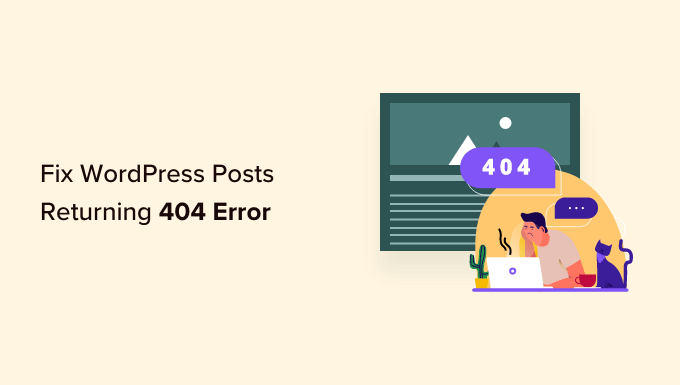
Perché gli articoli di WordPress restituiscono un errore 404?
Ci sono diversi motivi per cui i vostri post potrebbero mostrare un errore 404 “Pagina non trovata” in WordPress. Questi possono essere:
- Conflitti tra plugin o temi: A volte, i plugin o i temi installati sul sito possono interferire con il modo in cui WordPress gestisce i permalink. Ciò può causare la rottura dei colleghi e la comparsa di errori 404.
- Problemi di codice personalizzato: Se avete aggiunto del codice personalizzato al vostro sito web, potrebbero esserci errori nel codice che influenzano i permalink o causano altri conflitti, con conseguenti errori 404 per gli articoli.
- Problemi con il file .htaccess: Il file .htaccess svolge un ruolo nel modo in cui WordPress struttura gli URL. Se questo file è danneggiato o mancante, può causare errori 404 per i post o le pagine.
Come trovare tutti i post di WordPress con errori 404
Prima di passare alle soluzioni, sarebbe bene capire se l’errore si verifica solo in uno o due post o in più post. In questo modo, è possibile determinare la portata del problema e scegliere la soluzione più appropriata.
Un modo semplice per scoprirlo è utilizzare Google Search Console. Se non avete ancora inviato il vostro sito a Google Search Console, leggete la nostra guida su come aggiungere il vostro sito WordPress a Google Search Console.
Una volta che il bot di Google ha effettuato il crawling e l’indicizzazione del vostro sito, Google Search Console vi fornirà informazioni dettagliate sulle prestazioni del vostro sito, compresi gli errori 404 che incontra.
Per scoprire quali post restituiscono errori 404, è possibile accedere alla dashboard di Search Console. Quindi, navigate nel report “Pagine” e vedrete un elenco dettagliato di tutti gli errori.
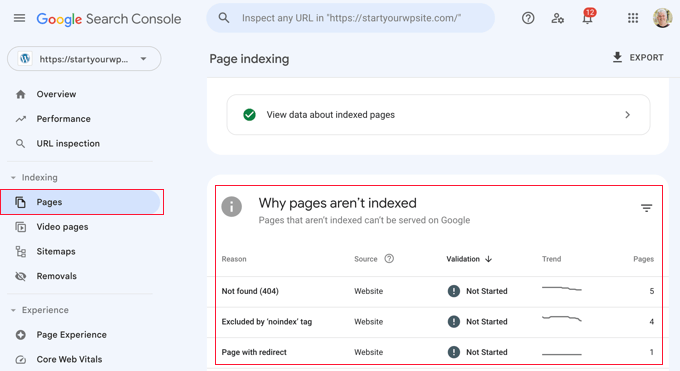
Per ulteriori informazioni, potete leggere il nostro elenco di suggerimenti per l’utilizzo di Google Search Console per aumentare il traffico del sito web, che include alcuni consigli su come risolvere gli errori 404 con lo strumento.
Detto questo, vediamo come correggere gli articoli di WordPress che restituiscono errori 404. Potete usare i colleghi qui sotto per passare direttamente alle diverse soluzioni:
Non avete tempo di risolvere da soli gli errori 404? I Servizi Pro di WPBeginner possono aiutarvi! Con la nostra conveniente Assistenza WordPress d’emergenza, potete assumere esperti per risolvere errori 404, link rotti, problemi di reindirizzamento e molto altro. Smettete di stressarvi per i problemi di WordPress e correggeteli! Programmate oggi stesso un servizio di assistenza WordPress di emergenza!
Metodo 1: Verificare la presenza di conflitti tra plugin o temi e problemi di codice personalizzato
A volte, i plugin, i temi o il codice personalizzato che avete aggiunto al vostro sito WordPress possono interferire con i permalink o causare conflitti, causando errori 404. Lo abbiamo sperimentato anche noi quando stiamo testando gli strumenti sul nostro sito demo.
Un modo per risolvere questo problema è disattivare temporaneamente i plugin. I plugin possono talvolta disturbare il modo in cui WordPress gestisce i colleghi.
Una volta disattivati i plugin, è possibile riattivarli uno per uno, selezionando se l’errore 404 ricompare dopo aver attivato ciascun plugin. Se l’errore compare dopo aver attivato un plugin specifico, il colpevole potrebbe essere quello.
È quindi possibile effettuare una rapida ricerca su Google per trovare soluzioni relative a quel plugin o contattare lo sviluppatore del plugin per ottenere assistenza.
Allo stesso modo, il tema di WordPress potrebbe essere la causa del conflitto.
Per selezionare, è possibile passare temporaneamente a un tema predefinito di WordPress, come Twenty Twenty-Three o Twenty Twenty-Four. Basta andare in Aspetto “ Temi e fare clic su ‘Attiva’ su un tema predefinito.

Se l’errore 404 scompare con il tema predefinito, ciò indica un potenziale conflitto con il tema corrente. Si può quindi provare a risolvere il problema del tema o prendere in considerazione l’utilizzo di un tema diverso.
Potete consultare la nostra selezione di esperti dei temi WordPress più popolari per avere consigli.
Se di recente avete inserito degli snippet di codice nel vostro sito web, potrebbero esserci degli errori nel codice che causano l’errore 404. Esaminate attentamente il codice che avete aggiunto e vedete se riuscite a individuare qualche errore.
Il modo più sicuro per aggiungere frammenti di codice a WordPress è il plugin WPCode. Questo plugin consente di inserire codice personalizzato senza intervenire direttamente sui file del tema, riducendo il rischio di rottura del sito web.
Inoltre, ogni volta che WPCode individua un errore nel codice, disattiva automaticamente lo snippet e chiede di selezionarlo. È anche possibile utilizzare la modalità di test per verificare se il codice funziona prima di inviarlo al sito web.
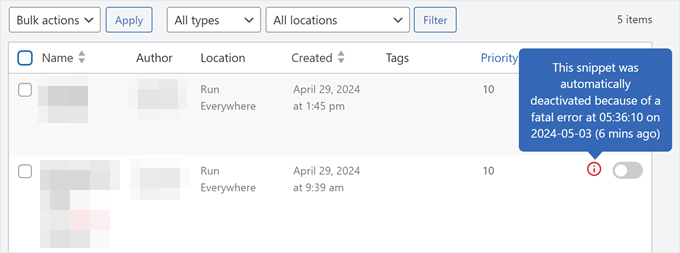
Se nessuna di queste soluzioni funziona, passate al metodo successivo, che prevede la risoluzione dei problemi relativi alle impostazioni dei permalink.
Metodo 2: correggere le impostazioni dei permalink
Gli articoli di WordPress possono restituire errori 404 a causa di problemi con le regole di riscrittura nel file .htaccess. Nella maggior parte dei casi, è possibile correggere il problema aggiornando le impostazioni dei permalink.
Basta andare su Impostazioni ” Permalinks nell’amministrazione di WordPress e fare clic sul pulsante “Salva modifiche”.
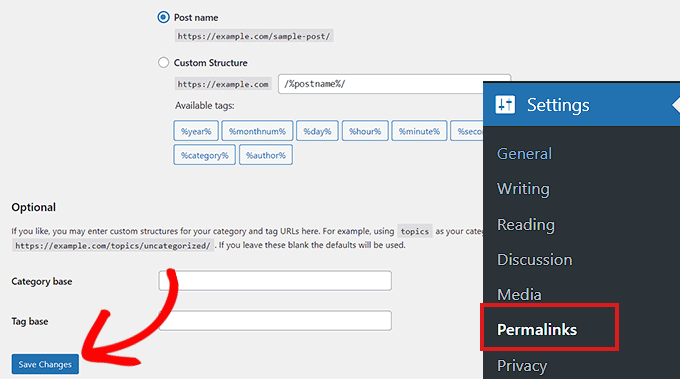
Non è necessario modificare le impostazioni dei permalink. Questa operazione aggiornerà le impostazioni dei permalink e cancellerà le regole di riscrittura.
Nella maggior parte dei casi, questa soluzione corregge l’errore 404 degli articoli di WordPress. Tuttavia, se non funziona, probabilmente è necessario aggiornare manualmente il file .htaccess.
Metodo 3: Aggiornamento del file .htaccess di WordPress
Prima di iniziare, assicuratevi di eseguire un backup del file .htaccess di WordPress. Se qualcosa dovesse andare storto, potrete facilmente ripristinare il file originale.
A questo punto, è necessario connettersi al server utilizzando un client FTP come FileZilla o l’applicazione File Manager nella dashboard del vostro hosting WordPress.
Successivamente, dovrete trovare e modificare il file .htaccess, che si trova nella stessa posizione di cartelle come /wp-content/ e /wp-includes/.
È sufficiente fare clic con il tasto destro del mouse sul file e selezionare “Autorizzazioni file”.
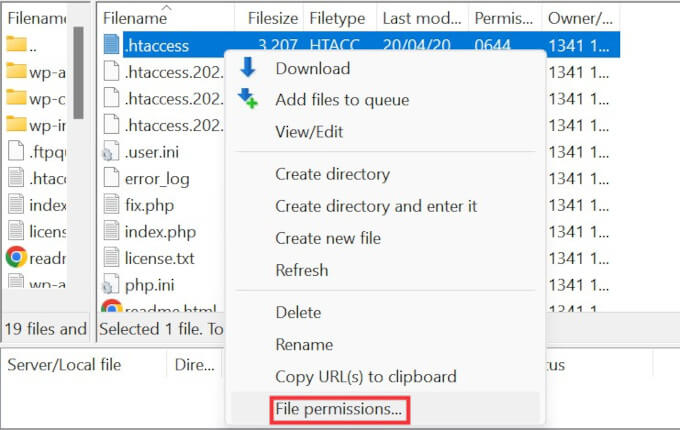
È possibile rendere il file scrivibile cambiando le autorizzazioni a 666.
Inserite semplicemente “666” nella casella “Valore numerico” e fate clic su “OK”.
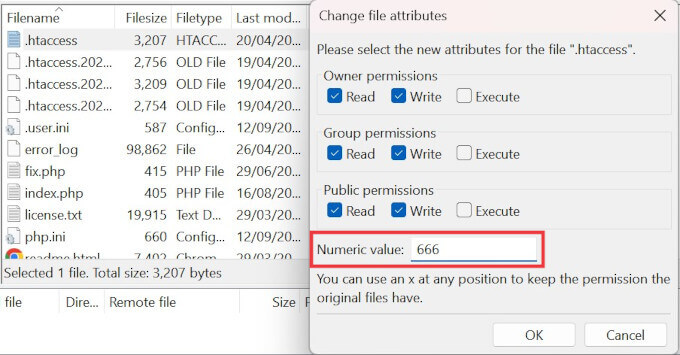
Quindi, è necessario ripetere i passaggi del primo metodo del nostro tutorial. Una volta fatto questo, non dimenticate di modificare le autorizzazioni in 660.
È anche possibile modificare il file e aggiungervi del codice.
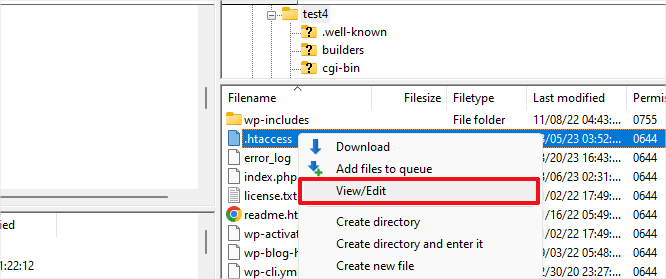
Una volta aperto il file .htaccess con un editor di testo, è sufficiente inserire questo codice:
1 2 3 4 5 6 7 8 9 10 | # BEGIN WordPress<IfModule mod_rewrite.c>RewriteEngine OnRewriteBase /RewriteRule ^index\.php$ - [L]RewriteCond %{REQUEST_FILENAME} !-fRewriteCond %{REQUEST_FILENAME} !-dRewriteRule . /index.php [L]</IfModule># END WordPress |
Metodo 4: contattare il fornitore di hosting
Se nessuna delle soluzioni sopra descritte ha corretto l’errore 404 degli articoli di WordPress, vi consigliamo di contattare il vostro fornitore di hosting WordPress. Potrebbe trattarsi di un errore on loro, oppure potrebbero aiutarvi a risolvere il problema.
NON SI TRADUCE la nostra guida su come richiedere correttamente l’assistenza WordPress e ottenerla.
Metodo 5: Abilitare il mod-rewrite (installazione locale di WordPress)
Se si utilizza un server locale a scopo di test, è necessario abilitare il mod_rewrite nella configurazione Apache del sito MAMP, WAMP o XAMPP.
Questo permetterà a WordPress di generare URL puliti e di evitare l’errore 404 per articoli e pagine sul server locale.
Il modo in cui farlo varia a seconda della piattaforma utilizzata. Chi usa XAMPP può aprire il proprio pannello di controllo e fare clic sul pulsante “Config” all’interno di Azioni. Quindi, selezionare “Apache (httpd.conf)”.
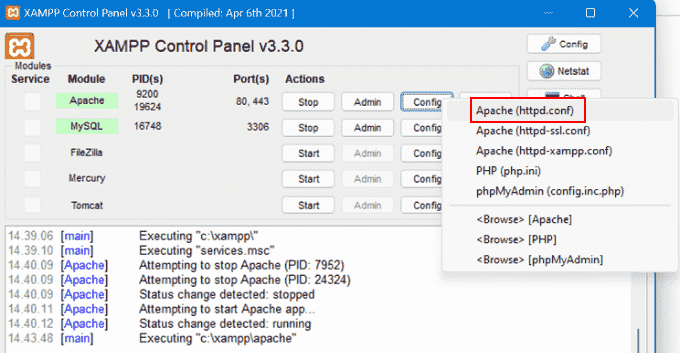
Successivamente, è necessario trovare questa riga #LoadModule rewrite_module modules/mod_rewrite.so e rimuovere il ‘#’ per decommentarla.
Questo caricherà il mod_rewrite.
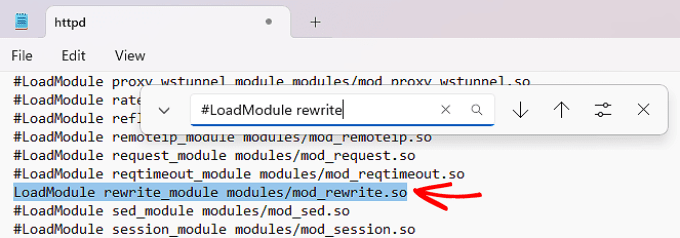
Quindi, individuare tutte le istanze di AllowOverride None e modificarle in AllowOverride All.
Il valore “Tutti” significa che tutte le direttive possono essere sovrascritte.
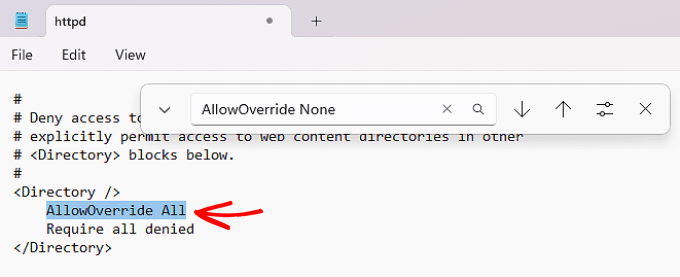
Una volta fatto, si può salvare il file httpd.conf e chiuderlo. Dopodiché, nel pannello di controllo di XAMPP, fate clic su ‘Stop’ sul modulo Apache e su ‘Start’ per riavviarlo.
Poi, tornate alla vostra Bacheca per vedere se i permalink funzionano.
Video tutorial
Se avete bisogno di istruzioni visive, guardate il video qui sotto.
Speriamo che questo articolo vi abbia aiutato a risolvere i post che restituiscono errori 404 in WordPress. Potreste anche voler consultare la nostra guida agli errori più comuni di WordPress e a come risolverli, insieme alle scelte dei nostri esperti sui migliori plugin WordPress per far crescere il vostro sito.
Se questo articolo vi è piaciuto, iscrivetevi al nostro canale YouTube per le esercitazioni video su WordPress. Potete trovarci anche su Twitter e Facebook.





Rj
thanks man u saved my life
Phannipha
Thank you for very useful sharing. Just only one click can solve the problem:)
Ehiz Mikey
A million thanks Syed. I was stuck here for a couple of weeks. A fix indeed.
Kaycee
Hi. Really nice article.
I had a 500 internal server error issue with my site when I tried using the W3 Total Cache plugin.
To fix this, I renamed the .htaccess file to .htaccessbak. After doing this, I noticed that the 500 error cleared but then I got a 404 error! All the links and pages on my site returned a 404.
On the All Pages section, I see a link that says “Purge from cache”
Please what do I do to clear this issue?
Stanley
You’re a life saver, worked for me.
Really grateful,
Thank you
syed
thanks it works for me….
Christian Fraunholz
but why is that happening and how to fix it forever?
Karma
I tried to follow your direction in fixing my problem, it took for about a day, but I didn’t find the good result.
Then I gave up and contacted my hosting. And it fixed only in 5 minutes. Lol the problem came from the hosting…
Mark Kay
By careful with post variables names. I had a contact form with an input field called “name”, that caused WordPress to show the 404 page. Took me a long time to figure out the problem. I fixed it be changing the field name from “name” to “your-name”.
Ivan
thanks you saved my life.
Ramzan
My problem is that I m going to wp adminin
And want to edit post it is not going in edit mode of post and page gives me error page not found 404 but my site and its pages are opening well in browser
Plz guide me I can solve this problem
Ben
Samo rpoblem here. Cannot edit the existing posts or add new one. I get 404 for both
Sunit
Hi, I have tried following the above steps but my issue is this: when I visit my website directly by putting typing the url, then it works fine. But, when i type in my site url in google search box and then click on the link from the search results, I get the 404 error or message saying “your connection is not private”.
My website is http://www.example.com but google search result shows it as https://example.com/
So not sure what the issue is. I used to have wordpress.com but now I am dong self-host using HG.
Any help will be appreciated.
Thanks
WPBeginner Support
www is considered a subdomain of a domain. So basically a site with www and without www will be considered two different sites by search engines. Go to Settings > General page to change your site URL from http://www.example.com to just example.com.
WordPress.com enabled https for all custom domains on WordPress.com. This means Google had already crawled your website with https in the URL. You can install free https using Let’s Encrypt.
Admin
Paul Nicholson
Great worked for me thanks!!
Shashdhar S
Thanks a lot , the second option worked for me ….. Thank you so muich
eliana
Just THANK YOU!
eli
WPBeginner Support
You are welcome Don’t forget to follow us on Twitter for more WordPress tips.
Don’t forget to follow us on Twitter for more WordPress tips.
Admin
Michaela
hi, I tried first solution, nothing happened. I wanted to try the second, but I cannot find the .htaccess file. Not in FTP, not even in my WP online editor. I had this issue today for the first time. I use WPML plugin, until now everything went without problem, but today my translated post in English throws this 404 Error. Any idea what shall I do if I cannot locate the .htaccess file?
Thanks!
Michaela
I noticed one thing. The post in the editor shows me the following link:
example.com/2016/09/15/where-eat-in-barcelona/?lang=en
but when I click to see the post, or from any RSS feed click on the published post, the link showing 404 error is as follows:
example.com/?p=11409&lang=en
WPBeginner Support
Please take a look at our guide on why you can’t find .htaccess file on your WordPress site.
Admin
Shirish Dhungel
Well thanks! I remember, that WP Super Cache official stated to remove rewrite code from .htaccess. After that, my posts redirected to 404. Thanks to you, now my site is perfectly fine.
Muhammad Nasir
Thanks it worked for me, thank you so much.
Akhelesh
Do I have to remove the code snippet I added to htacces file after my problem has been solved?
Jessica
Can someone contact me please? I am so new to these I don’t even know what a FTP server is…
WPBeginner Support
Please see our guide on using FTP.
Admin
Rohan khamkar
Sir, when I post a new post it gives me error that 404 page not found. Previously everything was fine but when I add a new user and give him a role of administrator from that time I can’t post new post. Any solution Please. Thank you in advance.
WPBeginner Support
You should never give administrator role to a user you don’t trust. You can always change back their role by going to Users page and then clicking on the Edit link below the user that you want to change. After that you check your site’s permalink structure. See if they installed any new plugin and if they did, then deactivate that plugin.
Admin
Shivani Sehdev
Wow……….. Solved a long ago problem .
Thanks A lot.
R Donahoo
Didn’t work on my apache server. Had an additional step to allow mod_rewrite to actually work. Edit your httpd.conf file and add ‘Allowoverride all’. For example:
DocumentRoot /var/www
find the section that sets up the directory options, such as:
Options Indexes FollowSymLinks MultiViews
Order allow,deny
allow from all
add Allowoverride all
Options Indexes FollowSymLinks MultiViews
AllowOverride all
Order allow,deny
allow from all
save and restart the web server to re-read the updated configuration.
All was well after that.
Thanks for your useful post moving me into the right direction.
Arnaud
forgot about htis #yaDaMan
Ben
Didn’t work for me either
Where can I find this file you are talking about
aderele olutayo samuel
this worked. …. Thanks
Eva
I found the some problem. However, I could not log in to the admin page. Could you give solution to mitigate this problem?
Rodrick Green
This was very easy and very helpful. THANKS A LOT!!!
B Pandey
thanks for your usefull tip. It worked for me on my website. Thanks a lot
sheldon
Thank you .
It worked for me
Rachit Sharma
but not working for me when i updated permalink with post name and change .htcces file but not worked. any other solution for that.
Ahsan
Wowww Thank you so much, that was really helpful.
In my case it was WAMP server, after turning on “rewrite module” in apache, my problem was solved.
Thanks.
Kailash
Wow – this still works. Done a search on google and found articles in wordpress but this was by far the simple-est and bang it works.
Thanks a mill – saved me a heap of time
WPBeginner Support
Glad you found it helpful.
Admin
Shawn Ritch
Hello and thanks for all the useful tips. Unfortunately, this tip didn’t work for me. I re-saved my permalinks in WordPress settings (didn’t work) so then I tried your next method and it didn’t work either. I’m thinking the reason for this is because I have different permissions. My original permission is 644. When I change permission to 660 none of my pages work so I believe the 666 permission is wrong as well. I’m using a Go Daddy server if that helps any :/
I’m at a loss and have no idea what to do from here. However, I can’t afford to have pages that don’t work. Any suggestions would be greatly appreciated.
Thanks
Shawn Ritch
Kevin Garcia
I tried this and it didn’t help me!!! My whole website crashed and had to restore it!!
Hannah Brown
Thanks, yours was the only place that told me HOW to fix my broken links! You’re the best
WPBeginner Support
Glad you found it helpful.
Admin
Kunal Yande
Thanks !!
You save my so much time….
Chris
How do I fix the issue when I upload a new plugin and then my categories, not posts, become 404?
Bob
This is great advice. I thought I was going to have to take a deep dive, but two clicks and I’m GTG. Thanks!
Ronn Reason
hi
i keep getting this message with my email account;
Error Oops… a server error occurred and your email was not saved. (#404)
Please advise ASAP
Gabo
O.O
I can’t belive this …. it works, thanks !!!!!
Steve
I had this problem after moving sites to a new server. Default Permalinks worked, but not the settings I was using.
I needed the apache server to “Allow Override” for the htaccess file to take effect.
Vivek
Hi,
I need a little help regarding 404 error.
I am getting 404 error in my Page 2 section.
I have googled a couple of times. but did not get the solution.
Could you please tell me what is the reason for it?
Rudy
My site links will work ONLY after I’ve VIEWED the permalink settings, without any changes, and Voila! The links work again. What is causing this and how can I program this instead of having to log in?
I’ve tried the following commands in WP-CLI to no avail:
wp rewrite flush –hard –path=c:\xampp\htdocs\mywordpress
wp cache flush –path=c:\xampp\htdocs\mywordpress
Amit Schandillia
This saved my life!!!!!
Patrick
Thanks man, just pressing the “Save changes” on the permalink-settings page did it for me! Cheers!
Amanda
Hi there,
About an hour ago I was able to remedy a pesky ‘500 Internal Service Error’ by following your sage advice and renaming the .htaccess file to .htaccess_old. I was immediately able to access my wp-admin area–and I thought–get going again.
Unfortunately, something happened which rendered all of my other pages unfindable; each kicking a 404 error.
I attempted the steps you provided above, but to no avail. Might you have any further suggestions?
Thank you.
Jessa
You guys are awesome, this was easy and fast. You guys save me a trouble!
mehdi
why i coudl not see my post?
after I send a post my preveous posts appear.
it made me crazy please remove previous post
…
I found a solution to my problem and will say in next post
mehdi
Hello agin
thank you for this useful article/ I found a bug in wordpress in rtl language in displaying permalink
I read your article and encourage to solve the problem with your contribute.
——————————————
my problem in detail:
1-I created a mysql database(in utf8 general ci)
2-I installed last wordpress versin(locally) and install my theme(multiup v 1.2 from themeforst)
3-Next I did import demo as whele.
in the theme admin panel exixst category portfolio (in this section we create our category with name and slug) then in all post under portfolio section we can create our posts and determine category of post from portfolio category) finally in homepage we have a section that shows portfolio post in category(with their picture)
In english slug and name the category of portfolio show well but when i change category in portfolio category( slug) into rtl language the category in homepage canvert into charachter like base 64(I think that my slug convert into ansi ie each character convert into 6 charachter)
How I can overcome my problem?I think I must avoid change slug or show slug into utf8 or unicode . I am beginer in wpordpress , If I khnew wordpress more I could solve this simple problem .Any one with khnowledge of handling hoock and filter and plugin and wordpress can solve this permalink problem . I sure I will solve this problem with your help.
———————————-
I tried the second way you offer (that phpmyadmin in utf8generalci) but it doee not work for me.
before thansk a lot for helping me.I followed your posts regularly .
……………………………….
1- first I did the trick in above article (this is so good but didnot solve my problem)
2-
mehdi
hello
thanks to contribute you knowledge to others .my english is not well.excuse me.
I download a wordpress theme with portfolio link in admin panel that in porftoli section we can define some category with name and slug . in post we can determine category from portfolio.
in homepage we can display post in portfolio category! all thing is ok but wen i chang name and slug into rtl language the title of a group in home page shows like this %d8%a8%d8%b1%d9%86%d8%af%d8%b3%d8%a7%d8%b2%db%8c
i did your solution in this topic and that another topic(How To Enable Custom Permalinks) but not woks for my problem!
WPBeginner Support
This could happen if your WordPress database is not using UTF-8 character encoding. Please make sure that your database is using utf8_general_ci as collation. You can check that using phpMyAdmin from cpanel. Before you make any changes to your database, please create a complete WordPress backup first.
Admin
Atula Gupta
Thank you so much for fixing my problem in seconds! I was panicking about all my posts giving this error and this solution was so simple! Thanks again.
Sammy
Thank you, thank you! This was making me crazy and you just helped me fix it in 2 seconds. High five.